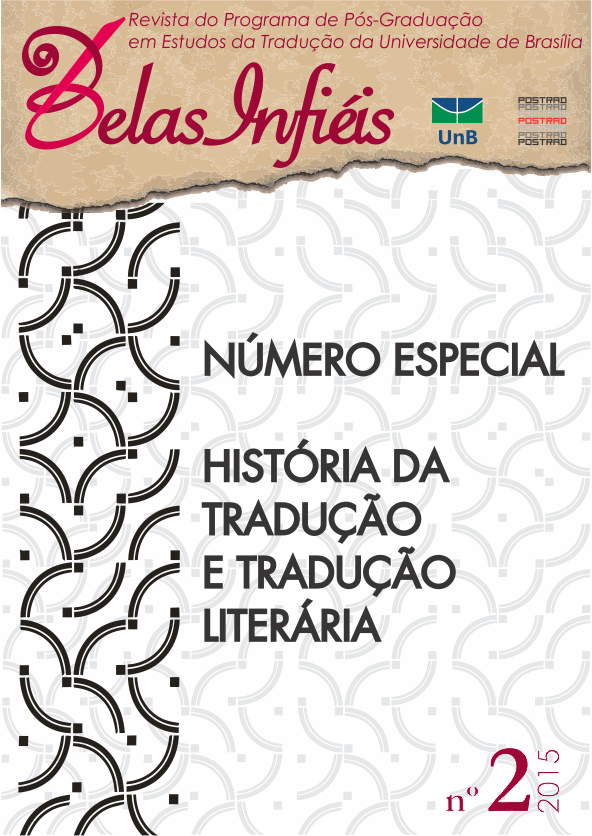BETWEEN THE GOOD NEIGHBOR POLICY AND THE LATIN AMERICAN “BOOM”:
BRAZILIAN LITERATURE IN THE UNITED STATES
DOI:
https://doi.org/10.26512/belasinfieis.v4.n2.2015.11340Keywords:
Translation, Harriet de Onís, Alfred A. Knopf, João Guimarães Rosa, Jorge AmadoAbstract
This article studies the translation of Brazilian literature in the United States between 1930 and the end of the 1960s. It analyzes political, historical and economic factors that influenced the publishing market for translations in the U.S., focusing on the editorial project of Alfred A. Knopf, the most influential publisher for Latin American literature in the U.S. during this period, and Harriet de Onís, who translated approximately 40 works from Spanish and Portuguese into English. In addition to translating authors such as João Guimarães Rosa and Jorge Amado, de Onís worked as a reader for Knopf, recommending texts for translation. The translator’s choices reflected the demands of the market and contributed to forming the canon of Brazilian literature translated in the United States.
Downloads
References
Archives:
HRC: Alfred A. Knopf, Inc. Archive, Harry Ransom Center. University of Texas at Austin.
IEB:João Guimarães Rosa archive, Instituto de Estudos Brasileiros, Universidade de São Paulo, São Paulo, Brazil.
SW: Sumner Welles Papers, Franklin D. Roosevelt Presidential Library, National Archives, Hyde Park, NY.
Other bibliographic references:
Adams, Mildred. Announcement for Knopf. 15 May 1963. JGR-R15,02,43, IEB.
Allen, Esther. “The Will to Translate: Four Episodes in a Local History of Global Cultural Exchange.” In Translation: Translators on Their Work and What it Means. Ed. Esther Allen and Susan Bernofsky. New York: Columbia University Press, 2013. Kindle file.
Armstrong, Piers. Third World Literary Fortunes. Lewisburg: Bucknell University Press, 1999.
Balch, Trudy. “Pioneer on theBridge of Language.” Américas. 50.6 (1998): 46-51.
Casanova, Pascale. The World Republic of Letters. Trans. M. B. DeBevoise. Cambridge, Massachusetts: Harvard University Press, 2004.
Cohn, Deborah N.The Latin American Literary Boom and U.S. Nationalism During the Cold War. Nashville: Vanderbilt University Press, 2012.
Cramer, Gisela and Ursula Prutsch. “Nelson A. Rockefeller’s Office of Inter-American Affairs (1940-1946) and Record Group 229.” Hispanic American Historical Review86.4 (2006): 785-806.
Damrosch, David. What is World Literature?Princeton, NJ: Princeton University Press, 2003.
De Onís, Juan. Personal interview. 21 February 2014.
_______. “The Town’s Story is the Land’s: A New Novel Depicts Tensions in Modern Brazil and the Influence ofan Unforgettable Woman.” The New York Times. 16 Sept. 1962.
Goldberg, Isaac, ed. and trans. Brazilian Tales. Boston: Four seas Co., 1921.
_______.Studies in Spanish-American Literature. New York: Brentano's, 1920.
Golyshev, Victor. “The Foundation Pitby Andrey Platonov: Two Translations into English.” Boston University, 13 April 2012. Lecture.
Hansen, João Adolfo. “Forma literária e crítica da lógica racionalista em Guimarães Rosa.” Letras de Hoje47.2 (April/June 2012): 120-130.
Isaacs, Jorge. Maria: A South American Romance. Trans. Rollo Ogden. New York: Harper & Brothers, 1890.
Krause, James Remington. “Translation and the Reception and Influence of Latin American Literature in the United States.” Diss. Vanderbilt U., 2010.
Lefevere, André. “Gates of Analogy: The Kavela in English”. Constructing Cultures: Essays on Literary Translation. Ed. Susan Bassnett and André Lefevere. Bristol, PA: Multilingual Matters, 1998. 76-89.
Levine, Suzanne Jill. “The Latin American Novel in English translation.” The Cambridge Companion to the Latin American Novel.Ed. Efraín Kristal. Cambridge, UK; New York: Cambridge University Press, 2005. 297-317.
Martinez, Felipe. “A Conversation with Dr. Piers Armstrong.” A Missing Book. 11 Feb. 2011. Web. 1 Sept. 2012.
Ogorzaly, Michael A.Waldo Frank, Prophet of Hispanic Regeneration. Lewisburg: Bucknell University Press, 1994.
Pane, Remigio U. “A Selected Bibliography of Latin American Literature in English Translation.” The Modern Language Journal26.2 (Feb. 1942): 116-122.
_____. “Two Hundred Latin American Books in English Translation: A Bibliography.” The Modern Language Journal27.8 (Dec. 1943): 593-604.
Rosa, João Guimarães. Grande Sertão: Veredas. 19th ed. Rio de Janeiro: Nova Fronteira, 2001.
____. Sagarana. Ed. Rio de Janeiro: Nova Fronteira, 2001.
____. Sagarana. Trans. Harriet de Onís. New York: Alfred A. Knopf, 1966.
____.The Devil to Pay in the Backlands. Trans. James L Taylor and Harriet de Onís. New York: Alfred A. Knopf, 1963.
Rostagno, Irene.Searching for Recognition: The Promotion of Latin American Literature in the United States. Westport, Conn.: Greenwood Press, 1997.
Sarmiento, Domingo Faustino. Facundo: Life in the Argentine Republic in the Days of the Tyrants;or Civilization and Barbarism. Trans. Mary Mann. New York: Hurd and Houghton, 1868.
Tota, Antonio Pedro. O amigo americano:Nelson Rockefeller e o Brasil. Rio de Janeiro: Companhia das Letras, 2014.
Venuti, Lawrence.The Translator’s Invisibility: A History of Translation. New York:Routledge, 1995.
Zilly, Berthold. “A ‘Transgermanização de Grande Sertão: Veredas.” Casa de Guilherme de Almeida, São Paulo, 7 Sept. 2014. Lecture.
____.“Os Sertõese Grande Sertão: Veredas: Reflexões do Tradutor”Literatura Brasileira:Região,Nação,Globalização. Eds. Germana Sales and Roberto Acizelo de Souza. Campinas, SP: Pontes, 2013. 311-3
Downloads
Published
How to Cite
Issue
Section
License
Given the public access to this journal, the texts are free to use but requires the recognition of the original authorship and initial publication in this journal to be properly stated.
 The journal allows the use of works published for non-commercial purposes, including the right to submit the work to publicly accessible databases. Published contributions are the sole and exclusive responsibility of the author(s).Â



















